The moon jellyfish is a carnivorous species, also known as Aurelia Aurita. Moon Jellyfish Eat mainly in organisms like crustaceans, tunicates, mollusks, young polychaetes, protozoans, fish eggs, larvae, rotifers, diatoms, planktons, and other small jellies.
Moon Jellyfish are using their tentacles to bring the food into their body for digestion. Below is detailed information on what type of species Moon Jellyfish feed on,
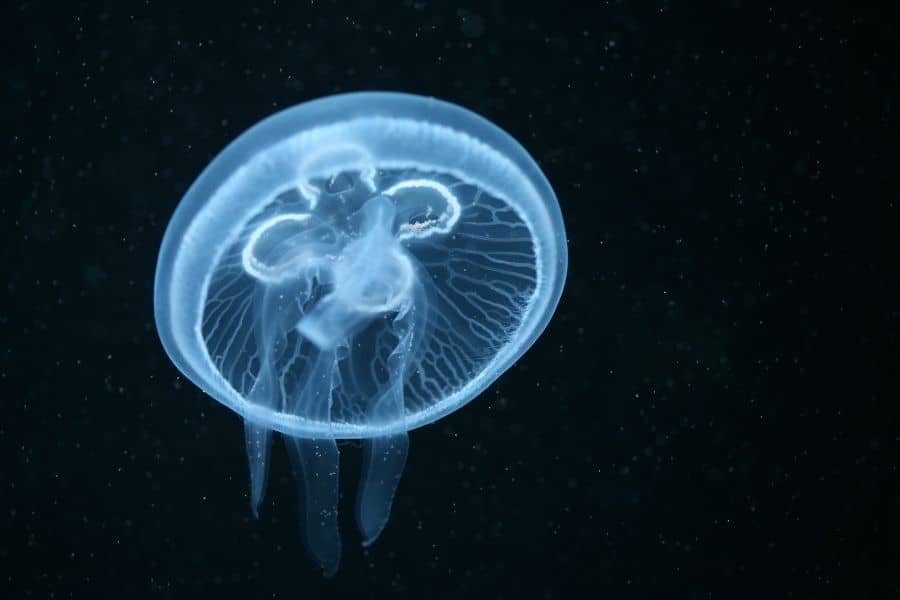
Moon Jellyfish food chain
Jump To
In the moon Jellyfish food chain, there are lots of creatures that they Feed. For example, some of the Moon Jellyfish food includes,
- Medusa
- Plankton
- Mollusks
- Crustaceans
- tunicate larvae
- rotifers
- young polychaetes
- protozoans
- diatoms
- eggs
- copepods
- nematodes
- hydromedusae
- ctenophores
and other small organisms.
Aurelia Aurita has very high proportions of polyunsaturated fatty acids (PUFAs). It is a fatty acid that contains more than one double bond, where they usually consist of essential fatty acids and those that give drying oils their characteristic property.
So, when comparing other prey, Aurelia Aurita consists of very high proportions of (PUFAs) which provide vital nutrition to predators.
For example, some of the moon jellyfish predators are Mola Mola (ocean sunfish), Leatherback sea turtle (phacellophora camtschatica or fried egg jellyfish, or egg york Jellyfish), crystal jelly ( hydrozoan jellyfish), and sea birds.
Moon Jellyfish food habit
Moon Jellies are Meat eaters. They eat tiny zooplankton, mollusk larvae, crustaceans, and small fishes. After a moon jelly has eaten, one can see food items in the Moon Jellyfish stomach, the bell flower-shaped organ.
Best food for the Moon Jellyfish
In the wild, Moon Jellyfish feeds on organisms like crustaceans, tunicate, mollusks, young polychaetes, protozoans, fish eggs, larvae, rotifers, diatoms, planktons, and other small jellies.
Still, when it comes to keeping a Moon Jellyfish as a pet, most grocery stores do not carry big bags of dry jellyfish food in the pet section.
Pet store selections are usually limited to dry fish flakes and pellets, where below we have mentioned the best alternative options to feed your Moon Jellies.
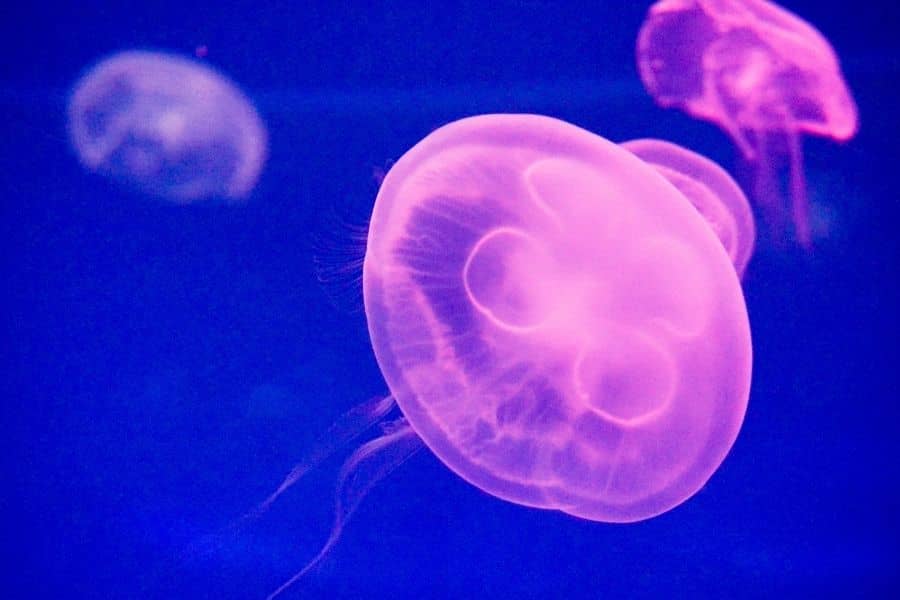
Baby Brine Shrimp
Baby Brine Shrimp is one of Moon Jellies’ favorite food sources. If you can cultivate your own live Brine Shrimp, that would be the best option.
Frozen Brine Shrimp
Moon Jellyfish only need a small amount of Frozen Brine Shrimp (about ¼ inch of a stick per 3 small jellies) floating freely in the water with them, and they will swim around plucking it out of the water on their own.
Finely chopped seafood.
You can use finely chopped seafood of your choice. Then, blend the seafood into a paste that can squirt into the water using a feeding tube.
I always recommend feeding live Baby Brine Shrimp alongside dried food, providing other nutrients, and keeping your Jellyfish in peak condition.
How To Feed Moon Jellyfish?
One of the most prevalent issues in maintaining Jellyfish as pets, unlike in the wild, is keeping them nutritionally satisfied. Most people are not sure just how much to feed to keep their Jellyfish healthy.
Jellies are passive feeders and need more food than you think. Lack of feeding makes them immediately lethargic and thin if they are not getting enough good food to eat.
So, by chance, if you are not feeding them enough nutritional food, your Jellyfish will start to wither and shrink.
The best way to feed Moon Jellyfish is by mixing any of the above mentioned into a paste, taking half a teaspoon, and squirting them into the water using a feeding tube when feeding.
You must never forget not to provide them with any vegetarian food since these are carnivore species and only feed on meat.
Always remember to squirt the paste near to the Moon Jellyfish and not onto the Moon Jellyfish.
Because squirting then near the Moon Jellyfish makes their tentacles stimulate so that they will swim toward catching the food, spraying them onto the Moon Jellyfish will not stimulate the tentacles to move, causing lethargy and a deterioration of the functionality of the tentacles.
You must always keep in mind that squirting liquid food into the tank may foul up the water.
Always remember that high pH levels in the water will stop the eating process of a Moon Jellyfish.
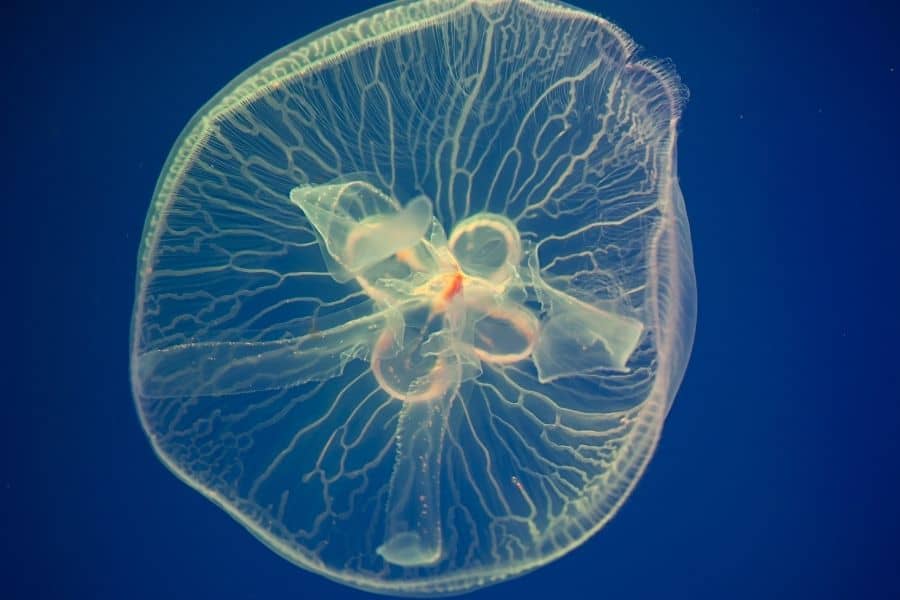
Always keep in mind that Moon Jellyfish are 95% water and have no brain, blood, or heart; feeding is a biological process.
Moon jellyfish are highly sensitive to changes in salinity, pH levels, and temperatures. Always remember to keep them in a stable environment, mainly while cleaning the tank.
After feeding
After feeding the Moon jellyfish, you can see the prey in the oral arms, and the stomach of the Jellyfish will turn into the prey’s color. It is easy to notice if they are getting enough food because you can see the contents of their stomachs.
How Do Moon Jellyfish eat their food?
Moon Jellyfish are suspension feeders that collect floating food particles by running into them.
Moon jellyfish have tentacles and oral arms which contain thousands of little stingers {referred to as Nematocysts} which inject the prey with a substance that will either paralyze them or kill them. You can generally see the stingers situated in the Oral Arms.
After the prey is stung, the Jellyfish usually uses its tentacles to catch the disabled prey to their oral arms, which will then move the prey towards their body.
Finally, the oral arms will retract, and the food will be moving into the mouth and moved to one of four stomachs.
Moon jellyfish normally eat food as often as possible, an enormous stomach that allows them to swallow food whole and break them down into pieces.
Moon jellyfish need a lot of protein, carbs, and liquids to live.
How long they go without food?
Moon Jellyfish can be fed once or twice a day, depending on your choice. These species can stay without feeding for nearly three days at a stretch, but it is better to feed them every day.
It would help if you fed them twice a day for them to get their daily nutrition. The best way to provides them with the nutrition is to feed them with live Baby Brine Shrimps.
Normally a Moon jellyfish can live up to a year or so in the wild or in captivity.
Related : Sand Sifting Starfish (Astropecten polycanthus) Care,
Related : Fairy Shrimp Vs. Brine Shrimp : Everything You Need To Know
What are Moon Jellyfish? and their Scientific name?
The name ‘moon jelly’ most likely came from their white, transparent, round bell or top. Their transparency can even cause the Jellyfish to look like they are glowing in the moonlight.
They are one of the most common species of Jellyfish. There are 13 types of species, and many are still not formally identified. For example, Aurelia is a genus of scyphozoan jellyfish, commonly called Moon Jellyfish, or saucer jelly.
Although these are widely studied species of genus aurelia, these genus species are closely related, and it is hard to identify Aurelia medusae without genetic sampling.
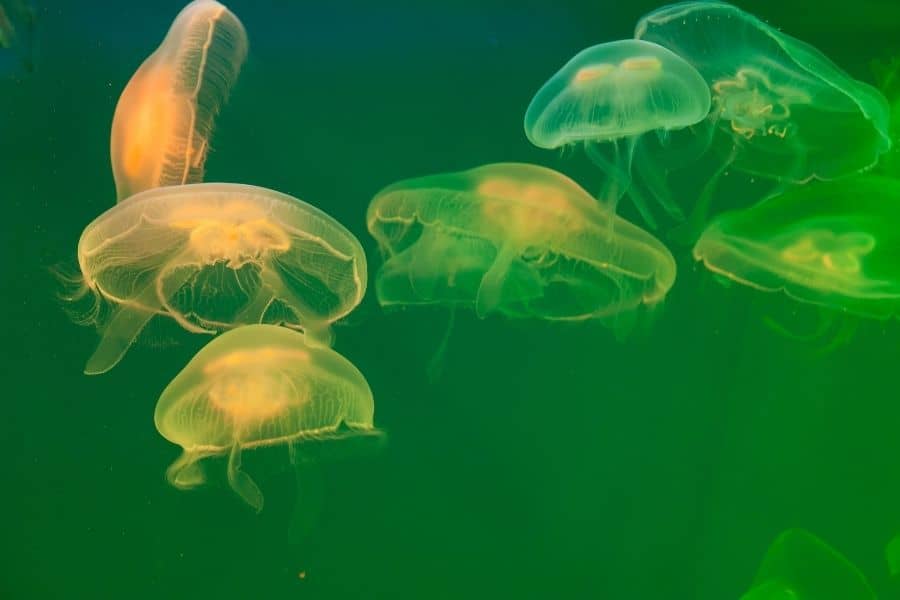
Identifying these species of the genus are commonly done through is selecting a jellyfish from a harbor using a drinking glass and then taking a photograph of the subject.
Historical researchers have claimed fossils that Jellyfish have been roaming in the oceans for more than 500 million years, which was discovered in Utah in the year of 2007. Surprisingly, these species have changed relatively little in all that time.
You can find these moon jellyfish in tropical waters, colder waters, and even in very cold environments. You can typically see these kinds of species just drifting in the ocean current for hundreds and thousands of miles since these species are not contained to reef settings.
And also sometimes you can see these Jellyfish on highly populated beaches in large number and very countries have taken measures to limit their population.
How To Identify Them?
The Moon Jellyfish offers several subspecies. It is impossible, though, to tell them apart without taking samples of their DNA.
They look too much alike in their physical appearance; however, they have no sexual reproduction organs that determine this.
So, again, it is determined by their DNA profiling. Moon Jellyfish reproduce as the eggs get fertilized.
The female release the fertilized eggs, which then transforms into larval forms called the ‘planula.’
These newly developed species float on the water surface till they find a solid surface to hold on to transform
The polyp transforms into small Jellyfish and then swims away individually when the conditions are favorable. We call them ‘ephyra.’ It is from this stage that the baby jellyfish metamorphose into adults.
Although Jellyfish are well known for their ability to sting, using harpoon-like cells on their tentacles to force toxins into their prey, the moon jelly possesses little danger to humans.
Appearance
The Moon Jellyfish are known for their beautiful appearance. Also called saucer jellyfish, scientists have not yet fully understood how long these Jellyfish have been on the earth. Aurelia Aurita is almost entirely translucent.
You can identify Moon Jellyfish by their four characteristic horseshoe-shaped gonads, which are usually about 25-40 cm or 10 – 16 inches in diameter.
Younger individuals commonly have patterns of spots and streaks along with a faint purple hue. These spineless animals are bioluminescent (glow in the dark) and a favorite item in the aquarium pet trade.
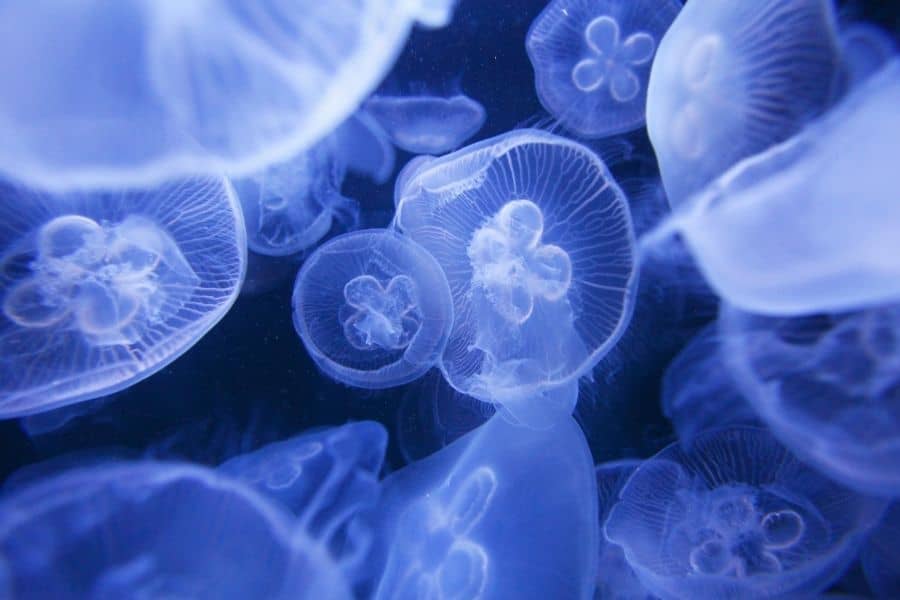
Where are they from?
Moon jellyfish, also known as Aurelia Aurita, is a genus of scyphozoan jellyfish. Species of Aurelia Aurita lives in the Atlantic Ocean, and the Arctic Ocean, and the Pacific Ocean and commonly live in the waters of Northern China, Japan, Korea, Australia, New Zealand, Black Sea, Off California, Indonesia, the eastern coast of the United States, and Europe.
Therefore, where most common locations you can find these Moon Jellyfish are Europe and North America.
There are two main types of moon jellyfish; Aurelia Labiate and Aurelia Aurita. You can find Aurelia labiate on the off coast of California, and you can discover Aurelia Aurita in much warmer waters.
Researches have shown a rapid increase in their numbers for the past years. Experts advise the reason for this is due to the low numbers of different types of predators in those areas.
However, the main fact in killing these Moon jellyfish is pollution since the moon jellyfish have a very delicate body that can cause diseases and other health issues and sometimes end up dying due to the toxic materials.
